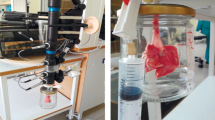Abstract
Transfer impedance (Z tr) of the respiratory system provides specific information on airways and tissues, but little is known about its spatial distribution in the different thoracoabdominal regions. To study Z tr distribution on the chest wall surface we analyzed five healthy subjects in the supine position by applying a sinusoidal forcing pressure (4, 8, and 12 Hz) at the mouth and measuring airway opening pressure and flow. Three-dimensional positions of 68 reflective markers placed on the chest wall over selected reference points were simultaneously measured by an optoelectronic motion analyzer. A subset of ten points placed on the midline were used to measure chest wall movements in the craniocaudal direction. While the motion of rib cage markers was synchronous, the abdominal markers demonstrated surface waves propagating caudally. The amplitude and phase of these waves were strongly dependent on position and frequency. We used a new method to measure total and local chest wall volume variations to compute the distribution of Z tr over the chest wall. Above 4 Hz we found that Z tr was inhomogeneously distributed and strongly dependent on position and frequency, mainly in the abdomen where the phase was often ≫180° with high values of modulus. For this reason, we conclude that above 8 Hz Z tr represents rib cage mechanics almost exclusively. © 2003 Biomedical Engineering Society.
PAC2003: 8719Uv, 8780-y
Similar content being viewed by others
REFERENCES
Aliverti, A., R. Dellaca, P. Pelosi, D. Chiumello, L. Gattinoni, and A. Pedotti. Compartmental analysis of breathing in the supine and prone positions by optoelectronic plethysmography. Ann. Biomed. Eng.29:60–70, 2001.
Aliverti, A., R. Dellaca, P. Pelosi, D. Chiumello, A. Pedotti, and L. Gattinoni. Optoelectronic plethysmography in intensive care patients. Am. J. Respir. Crit. Care Med.161:1546–1552, 2000.
Aliverti, A., R. L. Dellaca, and A. Pedotti. Transfer impedance of the respiratory system by forced oscillation technique and optoelectronic plethysmography. Ann. Biomed. Eng.29:71–82, 2001.
Barnas, G. M., K. Yoshino, S. H. Loring, and J. Mead. Impedance and relative displacements of relaxed chest wall up to 4 Hz. J. Appl. Physiol.62:71–81, 1987.
Barnas, G. M., K. Yoshino, D. Stamenovic, Y. Kikuchi, S. H. Loring, and J. Mead. Chest wall impedance partitioned into rib cage and diaphragm-abdominal pathways. J. Appl. Physiol.66:350–359, 1989.
Borghese, N. A., P. Cerveri, and G. C. Ferrigno. Statistical comparison of DLT versus ILSSC in the calibration of a photogrametric stereo system. J. Biomech.30:409–413, 1997.
Brusasco, V., E. Schiavi, L. Basano, and P. Ottonello. Comparative evaluation of devices used for measurement of respiratory input impedance in different centres. Eur. Respir. Rev.4:118–120, 1994.
Cala, S. J., C. M. Kenyon, G. Ferrigno, P. Carnevali, A. Aliverti, A. Pedotti, P. T. Macklem, and D. F. Rochester. Chest wall and lung volume estimation by optical reflectance motion analysis. J. Appl. Physiol.81:2680–2689, 1996.
Decramer, M., A. De Troyer, S. Kelly, L. Zocchi, and P. T. Macklem. Regional differences in abdominal pressure swings in dogs. J. Appl. Physiol.: Respir., Environ. Exercise Physiol.57:1682–1687, 1984.
Dellaca, R. L., A. Aliverti, P. Pelosi, E. Carlesso, D. Chiumello, A. Pedotti, and L. Gattinoni. Estimation of end-expiratory lung volume variations by optoelectronic plethysmography. Crit. Care Med.29:1807–1811, 2001.
DuBois, A. B., A. W. Brody, D. H. Lewis, and B. F. Burgess. Oscillation mechanics of lungs and chest in man. J. Appl. Physiol.8:587–594, 1956.
Jackson, A. C., and K. R. Lutchen. Physiological basis for resonant frequencies in respiratory system impedances in dogs. J. Appl. Physiol.70:1051–1058, 1991.
Lehr, J. L., J. P. Butler, P. A. Westerman, S. L. Zatz, and J. M. Drazen. Photographic measurement of pleural surface motion during lung oscillation. J. Appl. Physiol.59:623–633, 1985.
Lutchen, K. R., J. R. Everett, and A. C. Jackson. Impact of frequency range and input impedance on airway–tissue separation implied from transfer impedance. J. Appl. Physiol.74:1089–1099, 1993.
Lutchen, K. R., and A. C. Jackson. Confidence bounds on respiratory mechanical properties estimated from transfer versus input impedance in humans versus dogs. IEEE Trans. Biomed. Eng.39:644–651, 1992.
Lutchen, K. R., A. Sullivan, F. T. Arbogast, B. R. Celli, and A. C. Jackson. Use of transfer impedance measurements for clinical assessment of lung mechanics. Am. J. Respir. Crit. Care Med.157:435–446, 1998.
Marchal, F., N. Bouaziz, C. Baeyert, C. Gallina, C. Duvivier, and R. Peslin. Separation of airway and tissue properties by transfer respiratory impedance and thoracic gas volume in reversible airway obstruction. Eur. Respir. J.9:253–261, 1996.
Peslin, R., C. Duvivier, and C. Gallina. Total respiratory input and transfer impedances in humans. J. Appl. Physiol.59:492–501, 1985.
Peslin, R., C. Gallina, and C. Duvivier. Respiratory transfer impedances with pressure input at the mouth and chest. J. Appl. Physiol.61:81–86, 1986.
Peslin, R., J. Papon, C. Duviver, and J. Richalet. Frequency response of the chest: Modeling and parameter estimation. J. Appl. Physiol.39:523–534, 1975.
Rotger, M., R. Farro, R. Peslin, and D. Navajas. T model partition of lung and respiratory system impedances. J. Appl. Physiol.78:938–947, 1995.
Rotger, M., R. Peslin, C. Duvivier, D. Navajas, and C. Gallina. Density dependence of respiratory input and transfer impedances in humans. J. Appl. Physiol.65:928–933, 1988.
Rotger, M., R. Peslin, E. Oostveen, and C. Gallina. Confidence intervals of respiratory mechanical properties derived from transfer impedance. J. Appl. Physiol.70:2432–2438, 1991.
Tomalak, W., R. Peslin, and C. Duvivier. Variations in airways impedance during respiratory cycle derived from combined measurements of input and transfer impedances. Eur. Respir. J.12:1436–1441, 1998.
Tomalak, W., R. Peslin, C. Duvivier, and C. Gallina. Optimal frequency range to analyze respiratory transfer impedance with six-element model. J. Appl. Physiol.75:2656–2664, 1993.-
Author information
Authors and Affiliations
Rights and permissions
About this article
Cite this article
Dellacà, R.L., Aliverti, A., Lutchen, K.R. et al. Spatial Distribution of Human Respiratory System Transfer Impedance. Annals of Biomedical Engineering 31, 121–131 (2003). https://doi.org/10.1114/1.1541012
Issue Date:
DOI: https://doi.org/10.1114/1.1541012




